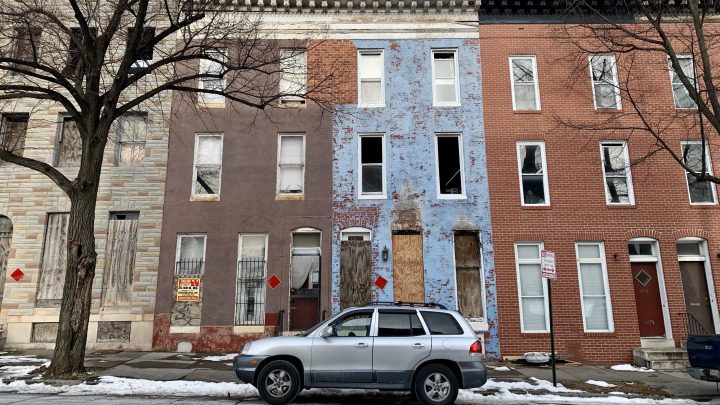
To fight vacant housing, Baltimore turns to the blockchain
To fight vacant housing, Baltimore turns to the blockchain

Ebony Thompson remembers vividly the day in 2022 she started a new job as deputy solicitor for the city of Baltimore. Her boss, Mayor Brandon Scott, held a press conference announcing steps the city would take to address vacant housing after three firefighters died on the job when part of an abandoned row house collapsed, trapping them inside.
The building was one of more than 15,000 vacant houses in Baltimore at the time.
“[Scott] said every agency has to come up with a way to contribute to battling and combating vacant housing,” Thompson, who’s now city solicitor, recalled. “I took that charge very seriously.”
Thompson had an idea. In her previous job, she’d taken a course at the Massachusetts Institute of Technology on blockchain technology. In simple terms, a blockchain is a shared, digital ledger that is immutable — meaning once a block of information is recorded, it can’t be changed. For her final class project, Thompson had proposed a way to use the technology in real estate transactions.
“It was putting deeds on the blockchain so that a municipality could save time and money to combat vacant housing,” she said.

Now she was working for a city battling vacant housing and asking for innovation. Still, it took some convincing to get officials on board.
“‘Ebony, why are you talking to us about cryptocurrency?’” she recalled some people asking. “I’m like, ‘It’s not cryptocurrency; it’s the technology behind cryptocurrency, and that’s just a small portion of what the technology does.’”
It took two years, during which Thompson was promoted to city solicitor, but earlier this month Scott, the mayor, announced a three-year pilot program to record all of the now 13,600 vacant properties in the city on the blockchain.
To explain how it’ll work, Housing Commissioner Alice Kennedy pulled up the city’s interactive community development map on her computer and zoomed in on a block of rowhouses, most of them marked with red squares, indicating vacancy. She clicked on 1415 Myrtle Ave., last sold in 1992. Records showed the house had been vacant since at least 2016, when an inspector deemed it unfit for human habitation.
The city’s main strategy for dealing with a house like that would be to acquire it through foreclosure or eminent domain, and then sell it to someone who would either fix it up and live in it or sell it to someone else.
“The first step we do with any type of acquisition process is needing to do a full title examination,” Kennedy explained. That’s the process of searching public records to find out who owns the building, if there are any unpaid taxes or bankruptcies, or if anyone else has a claim on the property. Those records are spread out across different agencies and courthouses.
“We are really turning over rocks,” she said.
The thing is, a title search typically happens every time a property changes hands, and that slows down getting that vacant building occupied, Kennedy said.
If all that information were easily accessible on the blockchain in a secure, unchangeable form, “we believe that that will then make the next transaction on that property go faster,” she said. The hope is that a faster process will also save money in title search and insurance costs.
This is just one piece of a proposed $3 billion plan to address blight in Baltimore. The city is hiring title attorneys to help acquire more properties faster and is starting a new bond program to subsidize redevelopment. Baltimore has made progress. The official number of vacant buildings has fallen 14% in the last three years, Kennedy said.
But you don’t have to look far to confront the challenges Baltimore is facing. After we talked, I drove over to see 1415 Myrtle Ave. It’s a brick rowhouse that someone had once painted sky blue. The windows were boarded up or missing entirely.

I found Charles Dugger doing some work at the house next door. He’s a retired teacher who grew up across the street.
“My grandfather bought 1404 back in 1912,” he said. “That’s been our family house for 112 years now.”
Over that time his family has lived through redlining and other racist policies that have hollowed out historically Black neighborhoods.
“I mean, you take away people’s legacy and culture,” he said. “Then we wonder, why is it like this?”
It’s going to take more than technology to overcome that history and bring this block back, but the city hopes it can at least help speed up the process.
There’s a lot happening in the world. Through it all, Marketplace is here for you.
You rely on Marketplace to break down the world’s events and tell you how it affects you in a fact-based, approachable way. We rely on your financial support to keep making that possible.
Your donation today powers the independent journalism that you rely on. For just $5/month, you can help sustain Marketplace so we can keep reporting on the things that matter to you.











